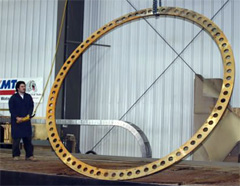
Waterjet cutting is one of the many ways of precision cutting. It uses a stream of water moving at rapid speeds and under extreme compression to cut a numerous array of substances. To be specific, the water employed by waterjet technologies move at speeds of approximately 2,000 feet per second, and under 90,000 pounds of pressure, per square inch.
One of the innumerable advantages of waterjet cutters is the ability to work a large number of different materials. Waterjet cutters work with both soft and hard materials, as well as various densities. This approach can cut anywhere from five-thousandths of an inch, to 7 inches thick. The ability to work with different materials and various thicknesses makes waterjet cutting also ideal for composites. When settings are adjusted for composite cutting, waterjet machines can cut up to 18 inches thick. That types of materials compatible with waterjet cutters are:
-
Inconel
-
Aluminum
-
Tool steel
-
Metal
-
Stainless steel
-
Titanium
-
Armour Plate
-
Marble
-
Ceramics
-
Granite
-
Stone
-
Bullet proof glass
-
Wood
-
Plastic
-
Foam
-
Rubber
As with most precision cutting methods, many variations of waterjet cutting exist. The two most well known forms are called pure waterjets and abrasive waterjets.
Pure waterjet cutters use water as the cutting solution. In abrasive waterjets, the water is mixed with substances like garnet, and aluminum oxide, to form an abrasive solution used to cut harder materials.
Abrasive waterjet processes can be further divided into either what is known as slurry methods, or entrainment methods.
The main difference between these two systems is how, and when the abrasives are combined with the water.
In abrasive slurry devices, the abrasives are added prior to pressurizing the water. Benefits of employing the slurry
system are:
However, the downfall of the slurry system is the ability to deteriorate all parts of the device. In entrained waterjet systems, the wearing of parts is restricted to the mixing compartment located in the waterjet head.
In an entrainment process the water is pressurized while attracting the abrasive particles into the quickly flowing water stream, as it exits the nozzle. Before leaving the orifice, the actual mixing of the water and abrasives take place in the mixing compartment. It then leaves the orifice of the nozzle and is directed at the workpiece.
Typically, any sort of waterjet cutting device contains:
-
CNC guide equipment
-
Microprocessor based control
-
Cantilever arm
-
Cutting table
-
Catch tank
-
Filtration system
-
Pressure pumps and pressure intensifiers
-
Disposal system for abrasives
-
Cutting nozzle
Different characteristics of the nozzle produces different cuts.
The shape of the nozzle opening alters the shape of the cuts created. It also aids in the attracting of abrasives in the mixing compartments of entrainment systems. As well, nozzles with narrower openings result with more precision and faster flowing waterjets.
There is also the option to use multiple nozzles, which allow for better control over the depth of the cut. Furthermore, when using multiple nozzles on one pressure intensifier at a time, the pressure of the water system can decrease.
There are several beneficial reasons to employ waterjet cutters. Each type of waterjet cutter available can work with a countless array of materials, and an impressive range of densities. Depending on the needs of the cutting task at hand, there is a water just cutting system available. Furthermore, it is important to remember that the nozzles of waterjet systems are changeable and can allow for more ease and precision to producing the desired cut.